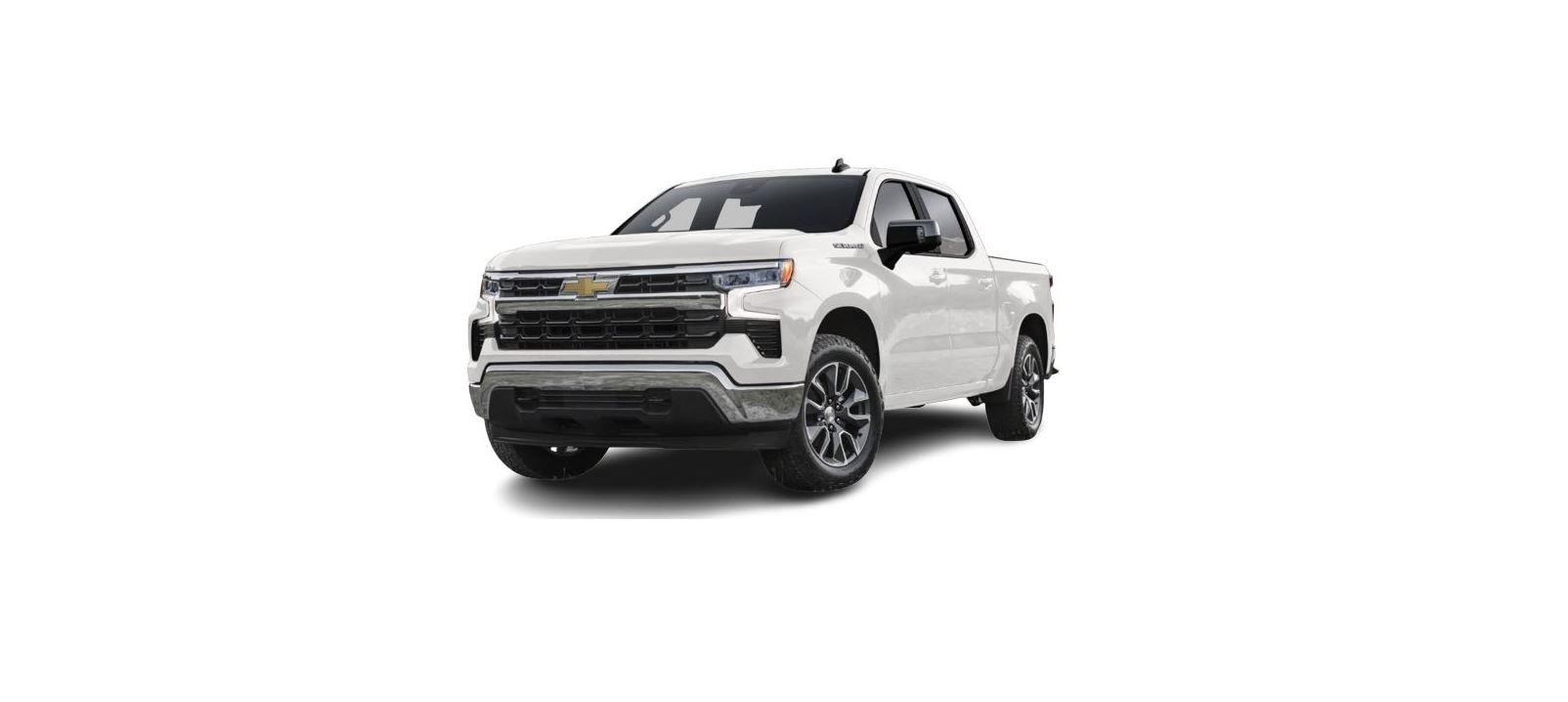2022 Chevrolet Silverado 1500 Wheels and Tires
 Wheels and Tires
Wheels and Tires
Tires
Every new GM vehicle has high-quality tires made by a leading tire manufacturer. See the warranty manual for information regarding the tire warranty and where to get service. For additional information refer to the tire manufacturer.
Warning
- Poorly maintained and improperly used tires are dangerous.
- Overloading the tires can cause overheating as a result of too much flexing. There could be a blowout and a serious crash. See Vehicle Load Limits 210.
- Underinflated tires pose the same danger as overloaded tires. The resulting crash could cause serious injury. Check all tires frequently to maintain the recommended pressure. Tire pressure should be checked when the tires are cold.
- Overinflated tires are more likely to be cut, punctured, or broken by a sudden impact — such as when hitting a pothole. Keep tires at the recommended pressure Worn or old tires can cause a crash. If the tread is badly worn, replace them.
- Replace any tires that have been damaged by impacts with potholes, curbs, etc.
- Improperly repaired tires can cause a crash. Only your dealer or an authorized tire service center should repair, replace, dismount, and mount the tires.
- Do not spin the tires in excess of 56 km/h (35 mph) on slippery surfaces such as snow, mud, ice, etc. Excessive spinning may cause the tires to explode
All-Season Tires
- This vehicle may come with all-season tires.
- These tires are designed to provide good overall performance on most road surfaces and weather conditions. Original equipment tires designed to GM’s specific tire performance criteria have a TPC specification code molded onto the sidewall. Original equipment all-season tires can be identified by the last two characters of this TPC code, which will be “MS.”
- Consider installing winter tires on the vehicle if frequent driving on snow or ice-covered roads is expected. All-season tires provide adequate performance for most winter driving conditions, but they may not offer the same level of traction or performance as winter tires on snow or ice-covered roads. See Winter Tires 0 375.
Winter Tires
- This vehicle was not originally equipped with winter tires. Winter tires are designed for increased traction on snow and ice-covered roads. Consider installing winter tires on the vehicle if frequent driving on ice or snow-covered roads is expected. See your dealer for details regarding winter tire availability and proper tire selection. Also, see Buying New Tires 0 388.
- With winter tires, there may be decreased dry road traction, increased road noise, and shorter tread life. After changing to winter tires, be alert for changes in vehicle handling and braking.
- If using winter tires:
- Use tires of the same brand and tread type on all four-wheel positions.
- Use only radial-ply tires of the same size, load range, and speed rating as the original equipment tires.
- Winter tires with the same speed rating as the original equipment tires may not be available for H, V, W, Y, and ZR speed rated tires. If winter tires with a lower speed rating are chosen, never exceed the tire’s maximum speed capability.
All-Terrain Tires
- This vehicle may have all-terrain or mud-terrain tires. These tires provide good performance on most road surfaces, weather conditions, and for off-road driving. See Off-Road Driving 203.
- The tread pattern on these tires may wear more unevenly than other tires. Consider rotating the tires more frequently than at 12 000 km (7,500 mi) intervals if irregular wear is noted when the tires are inspected. See Tire Inspection 0 386.
Tire Sidewall Labeling
Useful information about a tire is molded into its sidewall. The examples show a typical passenger and light truck tire sidewall.
- Tire Size: The tire size code is a combination of letters and numbers used to define a particular tire’s width, height, aspect ratio, construction type, and service description. See the “Tire Size” illustration in this section.
- TPC Spec (Tire Performance Criteria Specification) : Original equipment tires designed to GM’s specific tire performance criteria have a TPC specification code molded onto the sidewall. GM’s TPC specifications meet or exceed all federal safety guidelines.
- DOT (Department of Transportation): The Department of Transportation (DOT) code indicates that the tire is in compliance with the U.S. Department of Transportation Motor Vehicle Safety Standards. DOT Tire Date of Manufacture: The last four digits of the TIN indicate the tire manufactured date. The first two digits represent the week and the last two digits, the year. For example, the third week of the year 2020 would have a 4-digit DOT date of 0320. Week 01 is the first full week (Sunday through Saturday) of each year.
- Tire Identification Number (TIN) : The letters and numbers following the DOT code are the Tire Identification Number (TIN). The TIN shows the manufacturer and plant code, tire size, and date the tire was manufactured. The TIN is molded onto both sides of the tire, although only one side may have the date of manufacture.
- Tire Ply Material: The type of cord and number of plies in the sidewall and under the tread.
- Uniform Tire Quality Grading (UTQG) : Tire manufacturers are required to grade tires based on three performance factors: treadwear, traction, and temperature resistance. For more information, see Uniform Tire Quality Grading 0 390.
- Maximum Cold Inflation Load Limit: Maximum load that can be carried and the maximum pressure needed to support that load. For information on recommended tire pressure see Tire Pressure 0 381 and Vehicle Load Limits 0 210.
- Temporary Use Only: Only use a temporary spare tire until the road tire is repaired and replaced. This spare tire should not be driven over 112 km/h (70 mph), or 88 km/h (55 mph) when pulling a trailer, with the proper inflation pressure. See Full-Size Spare Tire 0 403.
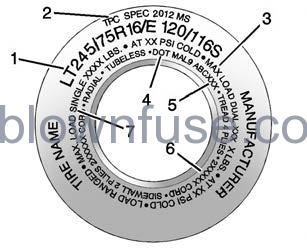
- Tire Size: The tire size code is a combination of letters and numbers used to define a particular tire’s width, height, aspect ratio, construction type, and service description. See the “Tire Size” illustration in this section.
- TPC Spec (Tire Performance Criteria Specification): Original equipment tires designed to GM’s specific tire performance criteria have a TPC specification code molded onto the sidewall. GM’s TPC specifications meet or exceed all federal safety guidelines.
- Dual Tire Maximum Load: Maximum load that can be carried and the maximum pressure needed to support that load when used in a dual configuration. For information on recommended tire pressure see Tire Pressure 0 381 and Vehicle Load Limits 210.
- DOT (Department of Transportation): The Department of Transportation (DOT) code indicates that the tire is in compliance with the U.S. Department of Transportation Motor Vehicle Safety Standards. DOT Tire Date of Manufacture: The last four digits of the TIN indicate the tire manufactured date. The first two digits represent the week and the last two digits, the year. For example, the third week of the year 2020 would have a 4-digit DOT date of 0320. Week 01 is the first full week (Sunday through Saturday) of each year.
- Tire Identification Number (TIN): The letters and numbers following the DOT code are the Tire identification number (TIN). The TIN shows the manufacturer and plant code, tire size, and date the tire was manufactured. The TIN is molded onto both sides of the tire, although only one side may have the date of manufacture.
- Tire Ply Material: The type of cord and number of plies in the sidewall and under the tread.
- Single Tire Maximum Load: Maximum load that can be carried and the maximum pressure needed to support that load when used as a single. For information on recommended tire pressure see Tire Pressure 0 381 and Vehicle Load Limits 210.
Tire Designations
Tire Size
The examples show a typical passenger vehicle and light truck tire size.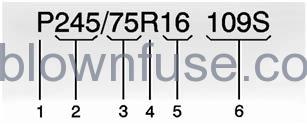
- Passenger (P-Metric) Tire: The United States version of a metric tire sizing system. The letter P as the first character in the tire size means a passenger vehicle tire engineered to standards set by the U.S. Tire and Rim Association.
- Tire Width: The 3-digit number indicates the tire section width in millimeters from sidewall to sidewall.
- Aspect Ratio: A 2-digit number that indicates the tire height-to-width measurements. For example, if the tire size aspect ratio is 75, as shown in item (3) of the tire illustration, it would mean that the tire’s sidewall is 75 percent as high as it is wide.
- Construction Code: A letter code is used to indicate the type of ply construction in the tire. The letter R means radial ply construction; the letter D means diagonal or bias ply construction.
- Rim Diameter: Diameter of the wheel in inches.
- Service Description: These characters represent the load index and speed rating of the tire. The load index represents the load-carrying1 capacity a tire is certified to carry. The speed rating is the maximum speed a tire is certified to carry a load.

- Light Truck (LT-Metric) Tire: The United States version of a metric tire sizing system. The letters LT as the first two characters in the tire size mean a light truck tire engineered to standards set by the U.S. Tire and Rim Association.
- Tire Width: The 3-digit number indicates the tire section width in millimeters from sidewall to sidewall.
- Aspect Ratio: A 2-digit number that indicates the tire height-to-width measurements. For example, if the tire size aspect ratio is 75, as shown in item 3 of the light truck (LT-Metric) tire illustration, it would mean that the tire’s sidewall is 75 percent as high as it is wide.
- Construction Code: A letter code is used to indicate the type of ply construction in the tire. The letter R means radial ply construction; the letter D means diagonal or bias ply construction.
- Rim Diameter: Diameter of the wheel in inches.
- Load Range: Load Range.
- Service Description: The service description indicates the load index and speed rating of a tire. If two numbers are given as in the example, 120/116, then this represents the load index for single versus dual-wheel usage (single/ dual). The speed rating is the maximum speed a tire is certified to carry a load.
Tire Terminology and Definitions
- Air Pressure: The amount of air inside the tire pressing outward on each square inch of the tire. Air pressure is expressed in kPa (kilopascal) or psi(pounds per square inch).
- Accessory Weight: The combined weight of optional accessories. Some examples of optional accessories are automatic transmission, power windows, power seats, and air conditioning.
- Aspect Ratio: The relationship of a tire’s height to its width.
- Belt: A rubber-coated layer of cords between the plies and the tread. Cords may be made from steel or other reinforcing materials.
- Bead: The tire bead contains steel wires wrapped by steel cords that hold the tire onto the rim.
- Bias Ply Tire: A pneumatic tire in which the plies are laid at alternate angles less than 90 degrees to the centerline of the tread.
- Cold Tire Pressure: The amount of air pressure in a tire, measured in kPa (kilopascal) or psi (pounds per square inch) before a tire has built up heat from driving. See Tire Pressure 0 381.
- Curb Weight: The weight of a motor vehicle with standard and optional equipment including the maximum capacity of fuel, oil, and coolant, but without passengers and cargo.
- DOT Markings: A code molded into the sidewall of a tire signifying that the tire is in compliance with the U.S. Department of Transportation (DOT) Motor Vehicle Safety Standards. The
- DOT code includes the Tire Identification Number (TIN), an alphanumeric designator that can also identify the tire manufacturer, production plant, brand, and date of production.
- GVWR: Gross Vehicle Weight Rating. See Vehicle Load Limits 0 210.
- GAWR FRT: Gross Axle Weight Rating for the front axle. See Vehicle Load Limits 0 210.
- GAWR RR: Gross Axle Weight Rating for the rear axle. See Vehicle Load Limits 0 210.
- Intended Outboard Sidewall: The side of an asymmetrical tire that must always face outward when mounted on a vehicle.
- Kilopascal (kPa): The metric unit for air pressure.
- Light Truck (LT-Metric) Tire: A tire used on light-duty trucks and some multipurpose passenger vehicles.
- Load Index: An assigned number ranging from 1 to 279 that corresponds to the load-carrying capacity of a tire.
- Maximum Inflation Pressure: The maximum air pressure to which a cold tire can be inflated. The maximum air pressure is molded onto the sidewall.
- Maximum Load Rating: The load rating for a tire at the maximum permissible inflation pressure for that tire.
- Maximum Loaded Vehicle Weight: The sum of curb weight, accessory weight, vehicle capacity weight, and production options weight.
- Normal Occupant Weight: The number of occupants a vehicle is designed to seat multiplied by 68 kg (150 lb). See Vehicle Load Limits 0 210.
- Occupant Distribution: Designated seating positions.
- Outward Facing Sidewall: The side of an asymmetrical tire that has a particular side that faces outward when mounted on a vehicle. The side of the tire that contains a whitewall, bears white lettering or bears manufacturer, brand, and/or model name molding that is higher or deeper than the same moldings on the other sidewall of the tire.
- Passenger (P-Metric) Tire: A tire used on passenger cars and some light duty trucks and multipurpose vehicles. Recommended Inflation Pressure :
- The vehicle manufacturer’s recommended tire inflation pressure as shown on the tire placard. See Tire Pressure 0 381 and Vehicle Load Limits 0 210.
- Radial Ply Tire: A pneumatic tire in which the ply cords that extend to the beads are laid at 90 degrees to the centerline of the tread.
- Rim: A metal support for a tire and upon which the tire beads are seated.
- Sidewall: The portion of a tire between the tread and the bead.
- Speed Rating: An alphanumeric code assigned to a tire indicating the maximum speed at which a tire can operate.
- Traction: The friction between the tire and the road surface. The amount of grip provided.
- Tread: The portion of a tire that comes into contact with the road.
- Treadwear Indicators: Narrow bands, sometimes called wear bars, that show across the tread of a tire when only 1.6 mm (1/16 in) of tread remains. See When It Is Time for New Tires 0 388. TAGS (Uniform Tire Quality Grading
- Standards) : A tire information system that provides consumers with ratings for a tire’s traction, temperature, and treadwear. Ratings are determined by tire manufacturers using government testing procedures. The ratings are molded into the sidewall of the tire. See Uniform Tire Quality Grading 390.
- Vehicle Capacity Weight: The number of designated seating positions multiplied by 68 kg (150 lb) plus the rated cargo load. See Vehicle Load Limits 210.
Tire Pressure
Tires need the correct amount of air pressure to operate effectively.
Warning
Neither tire underinflation nor overinflation is good. Underinflated tires, or tires that do not have enough air, can result in:
- Tire overloading and overheating, could lead to a blowout.
- Premature or irregular wear.
- Poor handling.
- Reduced fuel economy
Overinflated tires, or tires that have too much air, can result in:
- Unusual wear.
- Poor handling.
- Rough ride.
- Needless damage from road hazards.
- The Tire and Loading Information label on the vehicle indicates the original equipment tires and the correct cold tire inflation pressures.
- The recommended pressure is the minimum air pressure needed to support the vehicle’s maximum load carrying capacity.
- For additional information regarding how much weight the vehicle can carry, and an example of the Tire and Loading Information label, see Vehicle Load Limits 0 210. How the vehicle is loaded affects vehicle handling and ride comfort. Never load the vehicle with more weight than it was designed to carry.
When to Check
- Check the pressure of the tires once a month or more.
- Do not forget the spare tire, if the vehicle has one. See Full-Size Spare Tire 403 for additional information.
How to Check
- Use a good quality pocket-type gauge to check tire pressure. Proper tire inflation cannot be determined by looking at the tire. Check the tire inflation pressure when the tires are cold, meaning the vehicle has not been driven for at least three hours or no more than 1.6 km (1 mi).
- Remove the valve cap from the tire valve stem. Press the tire gauge firmly onto the valve to get a pressure measurement. If the cold tire inflation pressure matches the recommended pressure on the Tire and Loading Information label, no further adjustment is necessary. If the inflation pressure is low, add air until the recommended pressure is reached. If the inflation pressure is high, press on the metal stem in the center of the tire valve to release air.
- Re-check the tire pressure with the tire gauge.
- Put the valve caps back on the valve stems to keep out dirt and moisture.
- Use only valve caps designed for the vehicle by GM. TPMS sensors could be damaged and would not be covered by the vehicle warranty.
Tire Pressure Monitor System
- The Tire Pressure Monitor System (TPMS) uses radio and sensor technology to check tire pressure levels. The TPMS sensors monitor the air pressure in your tires and transmit tire pressure readings to a receiver located in the vehicle.

- Each tire, including the spare (if provided), should be checked monthly when cold and inflated to the inflation pressure recommended by the vehicle manufacturer on the vehicle placard or tire inflation pressure label. (If your vehicle has tires of a different size than the size indicated on the vehicle placard or tire inflation pressure label, you should determine the proper tire inflation pressure for those tires.)
- As an added safety feature, your vehicle has been equipped with a tire pressure monitoring system (TPMS) that illuminates a low tire pressure telltale when one or more of your tires is significantly under-inflated.
- Accordingly, when the low tire pressure telltale illuminates, you should stop and check your tires as soon as possible, and inflate them to the proper pressure. Driving on a significantly under-inflated tire causes the tire to overheat and can lead to tire failure. Under-inflation also reduces fuel efficiency and tire tread life and may affect the vehicle’s handling and stopping ability.
- Please note that the TPMS is not a substitute for proper tire maintenance, and it is the driver’s responsibility to maintain correct tire pressure, even if under-inflation has not reached the level to trigger illumination of the TPMS low tire pressure telltale.
- Your vehicle has also been equipped with a TPMS malfunction indicator to indicate when the system is not operating properly. The TPMS malfunction indicator is combined with the low tire pressure telltale. When the system detects a malfunction, the telltale will flash for approximately one minute and then remain continuously illuminated. This sequence will continue upon subsequent vehicle start-ups as long as the malfunction exists.
- When the malfunction indicator is illuminated, the system may not be able to detect or signal low tire pressure as intended. TPMS malfunctions may occur for a variety of reasons, including the installation of replacement or alternate tires or wheels on the vehicle that prevents the TPMS from functioning properly. Always check the TPMS malfunction telltale after replacing one or more tires or wheels on your vehicle to ensure that the replacement or alternate tires and wheels allow the TPMS to continue to function properly.
- See Tire Pressure Monitor Operation 0 382. See Radio Frequency Statement 447.
Tire Pressure Monitor Operation
- This vehicle may have a Tire Pressure Monitor System (TPMS). The TPMS is designed to warn the driver when a low tire pressure condition exists. TPMS sensors are mounted onto each tire and wheel assembly, excluding the spare tire and wheel assembly. The TPMS sensors monitor the air pressure in the tires and transmit the tire pressure readings to a receiver located in the vehicle.
- When a low tire pressure condition is detected, the TPMS illuminates the low tire pressure warning light located on the instrument cluster. If the warning light comes on, stop as soon as possible and inflate the tires to the recommended pressure shown on the Tire and Loading Information label. See Vehicle Load Limits 210.
- A message to check the pressure in a specific tire displayed in the Driver Information Center (DIC). The low tire pressure warning light and the DIC warning message come on at each ignition cycle until the tires are inflated to the correct inflation pressure. If the vehicle has DIC buttons, tire pressure levels can be viewed.
- For additional information and details about the DIC operation and displays, see Driver Information Center (DIC) (Base Level) 123 or Driver Information Center (DIC) (Uplevel) 125.
- The low tire pressure warning light may come on in cool weather when the vehicle is first started, and then turn off as the vehicle is driven. This could be an early indicator that the air pressure is getting low and needs to be inflated to the proper pressure.
- A Tire and Loading Information label shows the size of the original equipment tires and the correct inflation pressure for the tires when they are cold. See Vehicle Load Limits 0 210, for an example of the Tire and Loading Information label and its location. Also, see Tire Pressure 0 381.
- The TPMS can warn about a low tire pressure condition but it does not replace normal tire maintenance. See Tire Inspection 386, Tire Rotation 0 387, and Tires 0 374.
Caution
Tire sealant materials are not all the same. A non-approved tire sealant could damage the TPMS sensors. TPMS sensor damage caused by using an incorrect tire sealant is not covered by the vehicle warranty. Always use only the GM-approved tire sealant available through your dealer or included in the vehicle.
TPMS Malfunction Light and Message
The TPMS will not function properly if one or more of the TPMS sensors are missing or inoperable. When the system detects a malfunction, the low tire pressure warning light flashes for about one minute and then stays on for the remainder of the ignition cycle. A DIC warning message was also displayed. The malfunction light and DIC warning message come on at each ignition cycle until the problem is corrected. Some of the conditions that can cause these to come on are:
- One of the road tires has been replaced with a spare tire. The spare tire does not have a TPMS sensor. The malfunction light and the DIC message should go off after the road tire is replaced and the sensor matching process is performed successfully. See “TPMS Sensor Matching Process” later in this section.
- The TPMS sensor matching process was not done or not completed successfully after rotating the tires. The malfunction light and the DIC message should go off after successfully completing the sensor matching process. See “TPMS Sensor Matching Process” later in this section.
- One or more TPMS sensors are missing or damaged. The malfunction light and the DIC message should go off when the TPMS sensors are installed and the sensor matching process is performed successfully. See your dealer for service.
- Replacement tires or wheels do not match the original equipment tires or wheels.
- Tires and wheels other than those recommended could prevent the TPMS from functioning properly. See Buying New Tires 388.
- Operating electronic devices or being near facilities using radio wave frequencies similar to the TPMS could cause the TPMS sensors to malfunction.
- If the TPMS is not functioning properly, it cannot detect or signal a low tire pressure condition. See your dealer for service if the TPMS malfunction light and DIC message come on and stay on.
Tire Fill Alert (If Equipped)
This feature provides visual and audible alerts outside the vehicle to help when inflating an underinflated tire to the recommended cold tire pressure. When the low tire pressure warning light comes on:
- Park the vehicle in a safe, level place.
- Set the parking brake firmly.
- Place the vehicle in P (Park).
- Add air to the tire that is underinflated. The turn signal lamp will flash.
When the recommended pressure is reached, the horn sounds once and the turn signal lamp will stop flashing and briefly turn solid. Repeat these steps for all underinflated tires that have illuminated the low tire pressure warning light.
Warning
Overinflating a tire could cause the tire to rupture and you or others could be injured. Do not exceed the maximum pressure listed on the tire sidewall. See Tire Sidewall Labeling 0 376 and Vehicle Load Limits 210.
- If the tire is overinflated by more than35 kPa (5 psi), the horn will sound multiple times and the turn signal lamp will continue to flash for several seconds after filling stops. To release and correct the pressure, while the turn signal lamp is still flashing, briefly press the center of the valve stem.
- When the recommended pressure is reached, the horn sounds once.
- If the turn signal lamp does not flash within 15 seconds after starting to inflate the tire, the tire fill alert has not been activated or is not working.
- If the hazard warning flashers are on, the tire fill alert visual feedback will not work properly.
- The TPMS will not activate the tire fill alert properly under the following conditions:
- There is interference from an external device or transmitter.
- The air pressure from the inflation device is not sufficient to inflate the tire.
- There is a malfunction in the TPMS.
- There is a malfunction in the horn or turn signal lamps.
- The identification code of the TPMS sensor is not registered to the system.
- The battery of the TPMS sensor is low.
If the tire fill alert does not operate due to TPMS interference, move the vehicle about 1 m (3 ft) back or forward and try again. If the tire fill alert feature is not working, use a tire pressure gauge
TPMS Sensor Matching Process — Auto Learn Function
- Each TPMS sensor has a unique identification code. The identification code needs to be matched to a new tire/wheel position after rotating the tires or replacing one or more of the TPMS sensors. When a tire is installed, the vehicle must be stationary for about 20 minutes before the system recalculates. The following relearn process takes up to 10 minutes, driving at a minimum speed of 20 km/h (12 mph).
- A dash (-) or pressure value will display in the DIC. See Driver Information Center (DIC) (Base Level) 0 123 or Driver Information Center (DIC) (Uplevel) 125. A warning message displays in the DIC if a problem occurs during the relearn process.
Trailer Tire Pressure Monitoring Operation
- If equipped, the Trailer Tire Pressure Monitoring System (TTPMS) is designed to monitor the pressure of the trailer tires and warn the driver when a low-pressure condition exists.
- TTPMS sensors for four tires are provided. The system can accommodate a trailer with up to six tires if additional sensors are purchased from the dealer. Also, the system can be paired with up to five individual trailers.
- Prior to use, the vehicle must learn the sensors by following the learning process.
- See Trailering App 325.
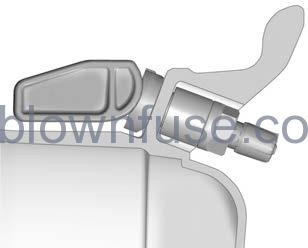
- Contact your trailer service center or tire service center to have the pressure sensors installed inside the trailer tires. The technician should insert the sensor stem through the hole in the trailer wheel. When the sensor is correctly positioned, the nut on the sensor stem should be tightened to 8Y(6 lb-ft). When mounting the trailer tire onto the trailer wheel be careful not to damage the sensor.
- The Trailering App can be used to view the tire pressures after the recommended trailer tire pressures have been entered. Refer to the trailer tire placard on the trailer or the trailer tire sidewall for the recommended tire pressure.
- The system is compatible with trailer tires that have placard pressure values from 103 – 689 kph (15 – 100 psi). The hole in the wheel for the tire stem must be either 11.43 mm (0.453 in) or 15.88 mm (0.625 in) in diameter. Use of the pressure sensors on a wheel with a different stem hole size could result in loss of air from the tire.
- If a low trailer tire pressure condition is detected, the TTPMS displays a warning message on the DIC. If the warning message is displayed, stop as soon as possible and inflate the tires to the recommended pressure shown on the tire placard on the trailer.
- In addition, the TTPMS monitors the temperature of the trailer tires. If the system detects a high temperature on one or more of the trailer tires, a warning message will be displayed on the DIC. If this warning message is displayed, stop as soon as possible, and inspect the overheated trailer tire. Common causes for high trailer tire temperature are underinflation, overloading, or tire damage.
TTPMS Malfunction Message
The TTPMS will not function properly if one or more of the trailer tire sensors are missing or inoperable. If the system detects a malfunction, a DIC message indicates that the system requires service. Some of the conditions that can cause the service message to occur are:
- One of the trailer tires has been replaced with the spare tire which does not have a learned TTPMS sensor. The DIC message should turn off after the pressure sensor is installed in the tire, and the learning process is performed successfully. See “TTPMS Sensor Learning Process” under Trailering App 0 325.
- The TTPMS sensor learning process was not done or not completed successfully. The DIC message should go off after successfully completing the sensor learning process. See “TTPMS Sensor Learning Process” under Trailering App 325.
- One or more TTPMS sensors are missing or damaged. The DIC message should go off when the TTPMS sensors are installed and the sensor learning process is performed successfully. See “TTPMS Sensor Learning Process” under Trailering App 0 325.
- Operating electronic devices or being near facilities using radio wave frequencies similar to the TTPMS could cause interference to the TTPMS which could cause a loss of signal reception from the sensor.
- If the system does not receive the signal from an individual sensor, an error message may not occur until the vehicle has been a driver for a period of time.
If the TTPMS is not functioning properly, it cannot detect or signal a low tire condition. See your dealer for service if the DIC message comes on and stays on when the trailer tire pressures have been checked and determined to be correct.
Tire Inspection
We recommend that the tires, including the spare tire if the vehicle has one, be inspected for signs of wear or damage at least once a month.
Replace the tire if:
- The indicators at three or more places around the tire can be seen.
- There is a cord or fabric showing through the tire’s rubber.
- The tread or sidewall is cracked, cut, or snagged deep enough to show a cord or fabric.
- The tire has a bump, bulge, or split.
- The tire has a puncture, cut, or other damage that cannot be repaired well because of the size or location of the damage.
Tire Rotation
- Tires should be rotated every 12 000 km (7,500 mi). See Maintenance Schedule 422.
- Tires are rotated to achieve a more uniform wear for all tires. The first rotation is the most important.
- Anytime unusual wear is noticed, rotate the tires as soon as possible, check for proper tire inflation pressure, and check for damaged tires or wheels. If the unusual wear continues after the rotation, check the wheel alignment.
- See When It Is Time for New Tires 0 388 and Wheel Replacement 0 391.

- Use this rotation pattern when rotating the tires.
- Do not include the spare tire in the tire rotation.
- Adjust the front and rear tires to the recommended inflation pressure on the Tire and Loading Information label after the tires have been rotated. See Tire Pressure 0 381 and Vehicle Load Limits 0 210.
- Reset the Tire Pressure Monitor System. See Tire Pressure Monitor Operation 382.
- Check that all wheel nuts are properly tightened. See “Wheel Nut Torque” under Capacities and Specifications 436.
Warning
Rust or dirt on a wheel, or on the parts to which it is fastened, can cause wheel nuts to become loose over time. The wheel could come off and cause a crash. When changing a wheel, remove any rust or dirt from places where the wheel attaches to the vehicle. In an emergency, a cloth or paper towel can be used; however, use a scraper or wire brush later to remove all rust or dirt.
Lightly coat the inner diameter of the wheel hub opening with wheel bearing grease after a wheel change or tire rotation to prevent corrosion or rust buildup.
Warning
Do not apply grease to the wheel mounting surface, wheel conical seats, or the wheel nuts or bolts. Grease applied to these areas could cause a wheel to become loose or come off, resulting in a crash.
When It Is Time for New Tires
- Factors, such as maintenance, temperatures, driving speeds, vehicle loading, and road conditions affect the wear rate of the tires.
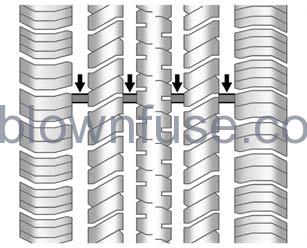
- Treadwear indicators are one way to tell when it is time for new tires. Treadwear indicators appear when the tires have only 1.6 mm (1/16 in) or less of tread remaining. See Tire Inspection 0 386 and Tire Rotation 0 387 for additional information.
- The rubber in tires ages over time. This also applies to the spare tire, if the vehicle has one, even if it is never used. Multiple factors including temperatures, loading conditions, and inflation pressure maintenance affect how fast aging takes place. GM recommends that tires, including the spare if equipped, be replaced after six years, regardless of tread wear. To identify the age of a tire, use the tire manufacture date, which is the last four digits of the DOT Tire identification number (TIN) molded into one side of the tire sidewall. The last four digits of the TIN indicate the tire manufactured date. The first two digits represent the week and the last two digits, the year. For example, the third week of the year 2020 would have a 4-digit DOT date of 0320. Week 01 is the first full week (Sunday through Saturday) of each year.
Vehicle Storage
- Tires age when stored normally mounted on a parked vehicle. Parka vehicle that will be stored for at least a month in a cool, dry, clean area away from direct sunlight to slow aging.
- This area should be free of grease, gasoline, or other substances that can deteriorate rubber.
- Parking for an extended period can cause flat spots on the tires that may result in vibrations while driving. When storing a vehicle for at least a month, remove the tires or raise the vehicle to reduce the weight from the tires.
Buying New Tires
- GM has developed and matched specific tires for the vehicle. The original equipment tires installed were designed to meet General Motors Tire Performance Criteria Specification (TPC Spec) system rating. When replacement tires are needed, GM strongly recommends buying tires with the same TPC Spec rating.
- GM’s exclusive TPC Spec system considers over a dozen critical specifications that impact the overall performance of the vehicle, including brake system performance, ride and handling, traction control, and tire pressure monitoring performance. GM’s TPC Spec number is molded onto the tire’s sidewall near the tire size. If the tires have an all-season tread design, the TPC Spec number will be followed by MS for mud and snow. See Tire Sidewall Labeling 376 for additional information.
- GM recommends replacing worn tires in complete sets of four. Uniform tread depth on all tires will help to maintain the performance of the vehicle. Braking and handling performance may be adversely affected if all the tires are not replaced at the same time. If proper rotation and maintenance have been done, all four tires should wear out at about the same time. However, if it is necessary to replace only one axle set of worn tires, place the new tires on the rear axle. See Tire Rotation 387.
Warning
Tires could explode during improper service. Attempting to mount or dismount a tire could cause injury or death. Only your dealer or authorized tire service center should mount or dismount the tires.
Warning
Mixing tires of different sizes (other than those originally installed on the vehicle), brands, tread patterns, or types may cause loss of vehicle control, resulting in a crash or other vehicle damage. Use the correct size, brand, and type of tire on all wheels.
Warning
Using bias-ply tires on the vehicle may cause the wheel rim flanges to develop cracks after many miles of driving. A tire and/or wheel could fail suddenly and cause a crash. Use only radial-ply tires with the wheels on the vehicle.
- Winter tires with the same speed rating as the original equipment tires may not be available for H, V, W, Y, and ZR speed rated tires. Never exceed the winter tires’ maximum speed capability when using winter tires with a lower speed rating.
- If the vehicle tires must be replaced with a tire that does not have a TPC Spec number, make sure they are the same size, load range, speed rating, and construction (radial) as the original tires.
- The Tire and Loading Information label indicates the original equipment tires on the vehicle. See Vehicle Load Limits 0 210.
Different Size Tires and Wheels
If wheels or tires are installed that are a different size than the original equipment wheels and tires, vehicle performance, including its braking, ride and handling characteristics, stability, and resistance to rollover may be affected. If the vehicle has electronic systems such as antilock brakes, rollover airbags, traction control, electronic stability control, or All-Wheel Drive, the performance of these systems can also be affected.
Warning
If different sized wheels are used, there may not be an acceptable level of performance and safety if tires not recommended for those wheels are selected. This increases the chance of a crash and serious injury. Only use GM-specific wheel and tire systems developed for the vehicle, and have them properly installed by a GM-certified technician.
Uniform Tire Quality Grading
- The following information relates to the system developed by the United States National Highway Traffic Safety Administration (NHTSA), which grades tires by treadwear, traction, and temperature performance. This applies only to vehicles sold in the United States. The grades are molded on the sidewalls of most passenger car tires.
- The Uniform Tire Quality Grading (UTQG) system does not apply to deep tread, winter tires, compact spare tires, tires with nominal rim diameters of10 to 12 inches (25 to 30 cm), or to some limited-production tires.
- While the tires available on General Motors passenger cars and light trucks may vary with respect to these grades, they must also conform to federal safety requirements and additional General Motors Tire Performance Criteria (TPC) standards.
- Quality grades can be found where applicable on the tire sidewall between tread shoulder and maximum section width. For example, Treadwear 200 Traction AA Temperature A All Passenger Car Tires Must Conform to Federal Safety Requirements In Addition To These Grades.
Treadwear
The treadwear grade is a comparative rating based on the wear rate of the tire when tested under controlled conditions on a specified government test course. For example, a tire graded 150 would wear one and one-half (1½) times as well on the government course as a tire graded 100. The relative performance of tires depends upon the actual conditions of their use, however, and may depart significantly from the norm due to variations in driving habits, service practices, and differences in road characteristics and climate.
Traction
The traction grades, from highest to lowest, are AA, A, B, and C. Those grades represent the tire’s ability to stop on wet pavement as measured under controlled conditions on specified government test surfaces of asphalt and concrete. A tire marked C may have poor traction performance. Warning: The traction grade assigned to this tire is based on straight-ahead braking traction tests and does not include acceleration, cornering, hydroplaning, or peak traction characteristics.
Temperature
The temperature grades are A (the highest), B, and C, representing the tire’s resistance to the generation of heat and its ability to dissipate heat when tested under controlled conditions on a specified indoor laboratory test wheel. A sustained high temperature can cause the material of the tire to degenerate and reduce tire life, and excessive temperature can lead to sudden tire failure. Grade C corresponds to a level of performance that all passenger car tires must meet under the Federal Motor SafetyStandard No. 109. Grades B and A represent higher levels of performance on the laboratory test wheel than the minimum required by law. Warning: The temperature grade for this tire is established for a tire that is properly inflated and not overloaded. Excessive speed, underinflation, or excessive loading, either separately or in combination, can cause heat buildup and possible tire failure.
Wheel Alignment and Tire Balance
The tires and wheels were aligned and balanced at the factory to provide the longest tire life and the best overall performance. Adjustments to wheel alignment and tire balancing are not necessary on a regular basis. Consider an alignment check if there is unusual tire wear or the vehicle is significantly pulling to one side or the other. Some slight pull to the left or right, depending on the crown of the road and/or other road surface variations such as troughs or ruts, is normal. If the vehicle is vibrating when driving on a smooth road, the tires and wheels may need to be rebalanced. See your dealer for a proper diagnosis.
Wheel Replacement
- Replace any wheel that is bent, cracked, badly rusted, or corroded. If wheel nuts keep coming loose, the wheel, wheel bolts, and wheel nuts should be replaced.
- If the wheel leaks air, replace it. Some aluminum wheels can be repaired. See your dealer if any of these conditions exist. Your dealer will know the kind of wheel that is needed.
- Each new wheel should have the same load-carrying capacity, diameter, width, offset, and be mounted the same way as the one it replaces.
- Replace wheels, wheel bolts, wheel nuts, or Tire Pressure Monitor System (TPMS) sensors with new GM original equipment parts.
Warning
Using the wrong replacement wheels, wheel bolts, or wheel nuts can bedangerous. It could affect the braking and handling of the vehicle. Tires can lose air and cause loss of control, resulting in a crash. Always use the correct wheel, wheel bolts, and wheel nuts for replacement.
Warning
Replacing a wheel with a used one is dangerous. How it has been used or how far it has been driven may be unknown. It could fail suddenly and cause a crash. When replacing wheels, use a new GM original equipment wheel.
Caution
The wrong wheel can also cause problems with bearing life, brake cooling, speedometer or odometer calibration, headlamp aim, bumper height, vehicle ground clearance, and tire or tire chain clearance to the body and chassis.
Tire Chains
Warning
- If the vehicle has 275/50R22, 275/60R20,LT265/60R20, LT265/70R17, LT275/65R18, or LT275/70R18 size tires, do not use tire chains. There is not enough clearance.
- Tire chains used on a vehicle without the proper amount of clearance can cause damage to the brakes, suspension, or other vehicle parts. The area damaged by the tire chains could cause loss of control and a crash.
- Use another type of traction device only if its manufacturer recommends it for thevehicle’s tire size combination and road conditions. Follow that manufacturer’s instructions. To avoid vehicle damage, drive slow and readjust or remove the traction device if it contacts the vehicle.
- Do not spin the wheels.
- If traction devices are used, install them on the rear tires.
Caution
If the vehicle is equipped with a tire size other than 275/50R22, 275/60R20, LT265/60R20, LT265/70R17, LT275/65R18, or LT275/70R18 use tire chains only where legal and only when necessary. Use chains that are the proper size for the tires. Install them on the tires of the rear axle. Do not use chains on the tires of the front axle. Tighten them as tightly as possible with the ends securely fastened. Drive slowly and follow the chain manufacturer’s instructions. If the chains contact the vehicle, stop and retighten them. If the contact continues, slow down until it stops. Driving too fast or spinning the wheels with chains on will damage the vehicle.
If a Tire Goes Flat
- It is unusual for a tire to blow out while driving, especially if the tires are maintained properly. If air goes out of a tire, it is much more likely to leak out slowly. But if there ever is a blowout, here are a few tips about what to expect and what to do:
- If a front tire fails, the flat tire creates a drag that pulls the vehicle toward that side.
- Take your foot off the accelerator pedal and grip the steering wheel firmly. Steer to maintain lane position, and then gently brake to a stop, well off the road, if possible.
- A rear blowout, particularly on a curve, acts much like a skid and may require the same correction as used in a skid. Stop pressing the accelerator pedal and steer to straighten the vehicle. It may be very bumpy and noisy. Gently brake to a stop, well off the road, if possible.
Warning
Driving on a flat tire will causepermanent damage to the tire. Re-inflating a tire after it has been drivenon while severely underinflated or flat may cause a blowout and a serious crash. Never attempt to re-inflate a tire that hasbeen driven on while severely underinflated or flat. Have your dealer or an authorized tire service center repair or replace the flat tire as soon as possible.
Warning
Lifting a vehicle and getting under it to do maintenance or repairs is dangerous without the appropriate safety equipmentand training. If a jack is provided with the vehicle, it is designed only for changing a flat tire. If it is used for anything else, you or others could be badly injured or killed if the vehicle slips off the jack. If a jack is provided with the vehicle, only use it for changing a flat tire.
If a tire goes flat, avoid further tire andwheel damage by driving slowly to a level place, well off the road, if possible. Turn on the hazard warning flashers. See Hazard Warning Flashers 143.
Warning
Changing a tire can be dangerous. The vehicle can slip off the jack and roll over or fall causing injury or death. Find a level place to change the tire. To help prevent the vehicle from moving:
- Set the parking brake firmly.
- Shift the vehicle to P (Park).
- For vehicles with four-wheel drive with an N (Neutral) transfer case position, be sure the transfer case is in a drive gear — not in N (Neutral).
- Turn off the engine and do not restart while the vehicle is raised.
- Do not allow passengers to remain in the vehicle.
- Place wheel blocks, if equipped, on both sides of the tire at the opposite corner of the tire being changed.
When the vehicle has a flat tire (2), use the following example as a guide to assist in the placement of the wheel blocks (1), if equipped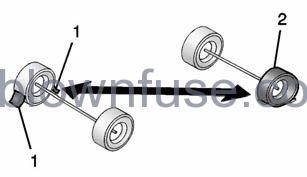
- Wheel Block (If Equipped)
- Flat Tire
The following information explains how to use the jack and change a tire.
Tire Changing
Removing the Spare Tire and Tools
- Jack
- Jack Knob
- Tool Kit
- Wing Nut Retaining Tool Kit
- Wheel Blocks
- Wing Nut Retaining Wheel Blocks
The equipment is under the second-row seats if equipped, or behind the front row seats on regular cab models.
- Turn the knob on the jack counterclockwise to lower the jack head to release the jack from its holder.
- Turn the wing nut counterclockwise to remove the wheel blocks and the wheel block retainer.
- Turn the wing nut used to retain the storage bag and tools counterclockwise to remove it.
Use the jack handle extensions and the wheel wrench to remove the underbody-mounted spare tire.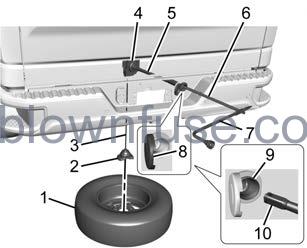
- Spare Tire (Valve Stem Pointed Down)
- Tire/Wheel Retainer
- Hoist Cable
- Hoist Assembly
- Hoist Shaft
- Jack Handle Extensions
- Wheel Wrench
- Hoist Shaft Access Hole Cover
- Hoist Shaft Access Hole
- Hoist End of Extension Tool
- Open the Hoist Shaft Access Hole Cover on the rear bumper (8).
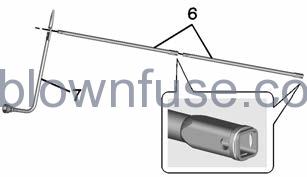
- Assemble the wheel wrench (7) and the two jack handle extensions (6), as shown
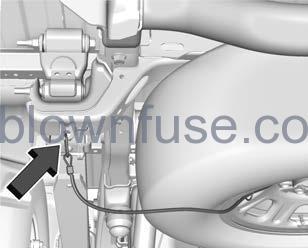
- If the vehicle is equipped with a spare tire cable disconnect the cable from the attachment on the frame by unclipping it from the frame attachment bracket
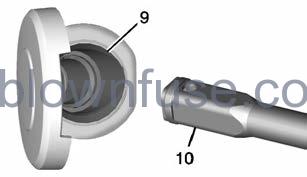
- Insert the hoist end (open end) (10) of the extension through the hole (9) in the rear bumper. Do not use the chiseled end of the wheel wrench. Be sure the hoist end of the extension (10) connects to the hoist shaft. The ribbed square end of the extension is used to lower the spare tire.
- Turn the wheel wrench counterclockwise to lower the spare tire to the ground. Continue to turn the wheel wrench until the spare tire can be pulled out from under the vehicle.
- Pull the spare tire out from under the vehicle.

- Tilt the tire toward the vehicle with some slack in the cable to access the tire/wheel retainer.
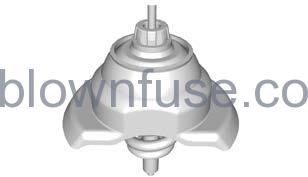 Tilt the retainer and pull it through the center of the wheel along with the cable and spring.
Tilt the retainer and pull it through the center of the wheel along with the cable and spring. - Put the spare tire near the flat tire.

- If equipped with a spare tire cable remove the cable from the spare tire bypassing the clip through the looped end of the cable.
Removing the Flat Tire and Installing the Spare Tire
Use the following pictures and instructions to remove the flat tire and raise the vehicle.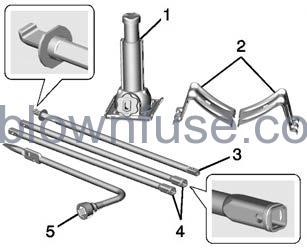
- Jack
- Wheel Blocks
- Jack Handle
- Jack Handle Extensions
- Wheel Wrench
The tools you will be using include the jack (1), the wheel blocks (2), the jack handle (3), the jack handle extensions (4), and the wheel wrench (5).
- Do a safety check before proceeding. See If a Tire Goes Flat 392.
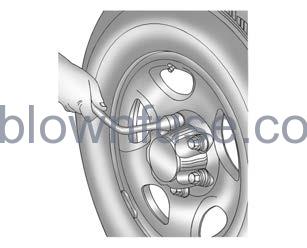
- If the vehicle has wheel nut caps, loosen them by turning the wheel wrench counterclockwise.
- If the vehicle has a center cap with wheel nut caps, the wheel nut caps are designed to stay with the center cap after they are loosened. Remove the entire center cap.
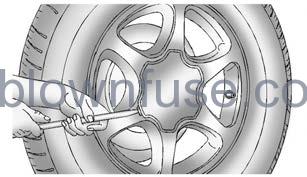
- If the wheel has a smooth center cap, concealing access to the wheel nuts, place the chisel end of the wheel wrench in the slot on the wheel, and gently pry it out.
- If the wheel’s center cap does not conceal the wheel nuts, the center cap may remain during wheel removal. If the removed wheel is to be stowed in the hoist, the cap needs to be detached from the wheel. Access the wheel from the backside, and use a jack handle extension to push out the center cap.
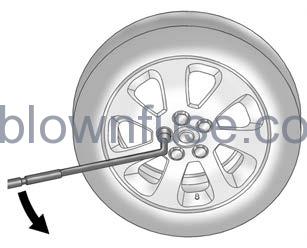
- If the vehicle has a center cap with wheel nut caps, the wheel nut caps are designed to stay with the center cap after they are loosened. Remove the entire center cap.
- Use the wheel wrench and turn it counterclockwise to loosen the wheel nuts. Do not remove the wheel nuts yet.
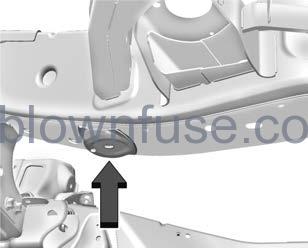
- If the flat tire is on the front of the vehicle, position the jack under the bracket attached to the vehicle’s frame, behind the flat tire, as shown.

- If the flat tire is on the rear, position the jack under the rear axle about 5 cm (2 in) inboard of the shock absorber bracket.
- Turn the wheel wrench clockwise to raise the vehicle. Raise the vehicle far enough off the ground so there is enough room for the spare tire to fit under the wheel well.
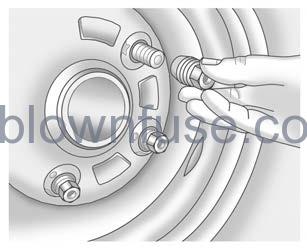
- Remove all the wheel nuts and take off the flat tire.
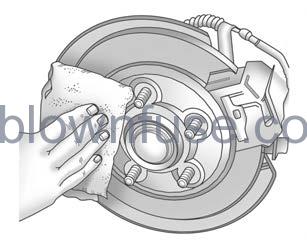
- Remove any rust or dirt from the wheel bolts, mounting surfaces, and spare wheel.
- Install the spare tire.
- Put the wheel nuts back on with the rounded end of the nuts toward the wheel.
- Tighten each wheel nut by hand. Then use the wheel wrench to tighten the nuts until the wheel is held against the hub.
- Turn the wheel wrench counterclockwise to lower the vehicle. Lower the jack completely
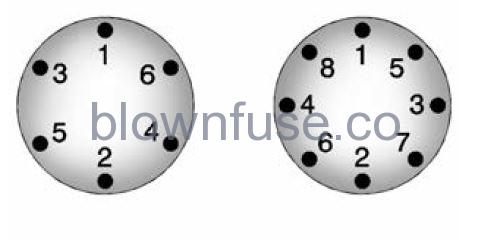
- Tighten the nuts firmly in a crisscross sequence, as shown, by turning the wheel wrench clockwise.
When reinstalling the regular wheel and tire, also reinstall either the center cap or bolt-on hub cap, depending on what the vehicle is equipped with. For center caps, place the cap on the wheel and tap it into place until it seats flush with the wheel. The cap only goes on one way. Be sure to line up the tab on the center cap with the indentation on the wheel. For bolt-on hub caps, align the plastic nut caps with the wheel nuts and then tighten by hand. Then use the wheel wrench to tighten.
Storing a Flat or Spare Tire and Tools
Warning
Storing a jack, a tire, or other equipment in the passenger compartment of the vehicle could cause injury. In a sudden stop or collision, loose equipment could strike someone. Store all these in the proper place.
Warning
Failure to follow these tire storage instructions carefully could result in personal injury or property damage if the hoist cable fails or if the tire comes loose. Make sure the tire is stored securely before driving.
Caution
Storing an aluminum wheel with a flat tire under your vehicle for an extended period of time or with the valve stem pointing up can damage the wheel. Always stow the wheel with the valve stem pointing down and have the wheel/ tire repaired as soon as possible.
Caution
The tire hoist can be damaged if there is no tension on the cable when using it. To have the necessary tension, the spare or road tire and wheel assembly must be installed on the tire hoist to use it.
Warning
An improperly stored spare tire could come loose and cause a crash. To avoid personal injury or property damage, always store the spare tire when the vehicle is parked on a level surface.
Store the tire under the rear of the vehicle in the spare tire carrier.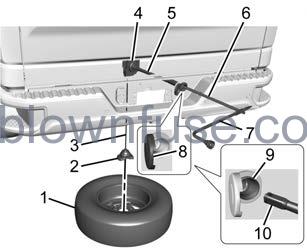
- Spare Tire (Valve Stem Pointed Down)
- Tire/Wheel Retainer
- Hoist Cable
- Hoist Assembly
- Hoist Shaft
- Jack Handle Extensions
- Wheel Wrench
- Hoist Shaft Access Hole Cover
- Hoist Shaft Access Hole
- Hoist End of Extension Tool
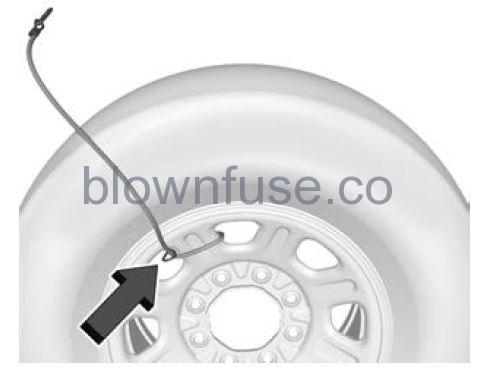
- Spare Tire Cable (If Equipped)
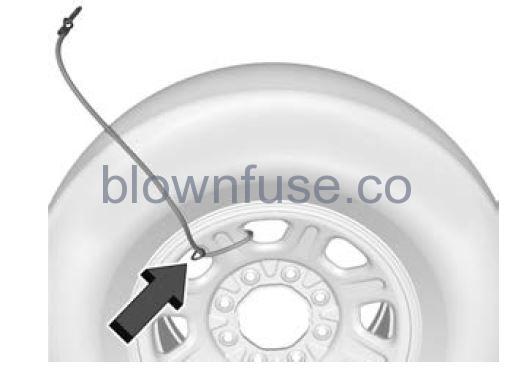
- If equipped with a spare tire cable, reinstall the cable to the spare wheel by looping the cable around a wheel vent window then pass the clip end of the cable through the looped end. The excess cable wire should be on the valve stem side of the spare tire.
- Put the tire on the ground at the rear of the vehicle with the valve stem pointed down, and to the rear.
- Pull the cable and spring through the center of the wheel. Tilt the wheel retainer plate down and through the center wheel.
Make sure the retainer is fully seated across the underside of the wheel.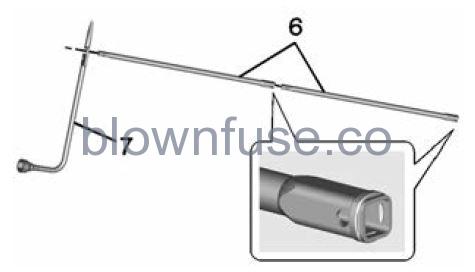
- Attach the wheel wrench (7) and extensions (6) together, as shown.

Caution: Use of an air wrench or other power tools with the hoist mechanism is not recommended and could damage the system. Use only the tools supplied with the hoist mechanism. - Insert the hoist end (10) through the hole (9) in the rear bumper and onto the hoist shaft.
- Do not use the chiseled end of the wheel wrench.
- Raise the tire part way upward. Make sure the retainer is seated in the wheel opening
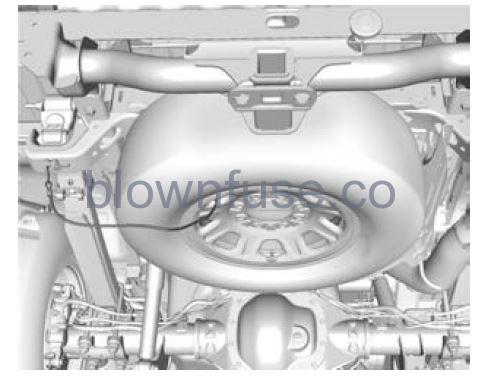
- If equipped with a spare tire cable, orient the cable by rotating the spare tire so that the cable is by the frame attachment location.
- Raise the tire fully against the underside of the vehicle by turning the wheel wrench clockwise until you hear two clicks or feel it skip twice. You cannot overtighten the cable.
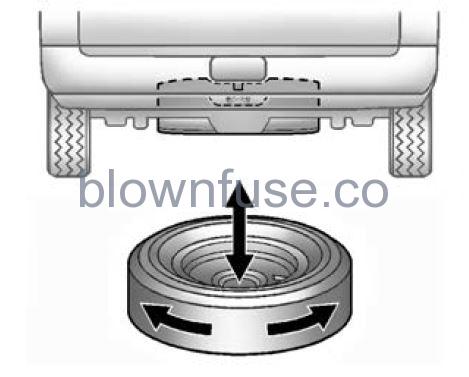
- Make sure the tire is stored securely. Push, pull, and then try to turn the tire. If the tire moves, use the wheel wrench to tighten the cable.
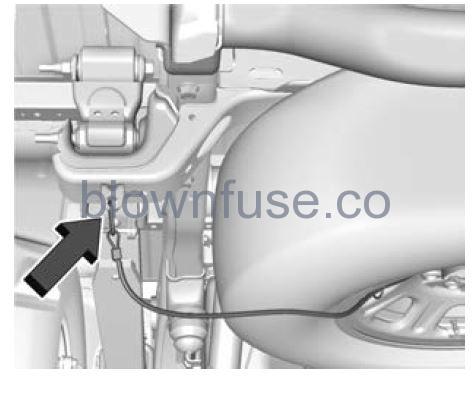
- If equipped with a spare tire cable, reattach the clip to the frame attachment bracket. Note that there may be slack in the cable.
- Repeat this tightness check procedure when checking the spare tire pressure according to the scheduled maintenance information or any time the spare tire is handled due to the service of other components.
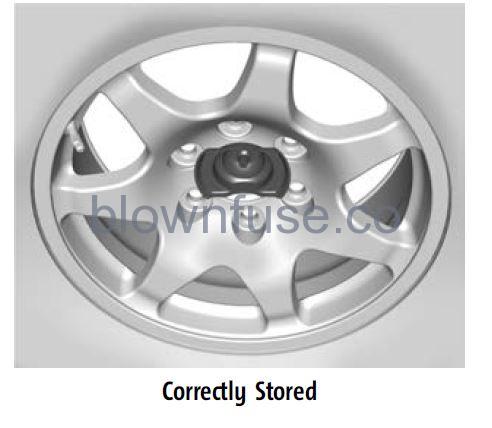
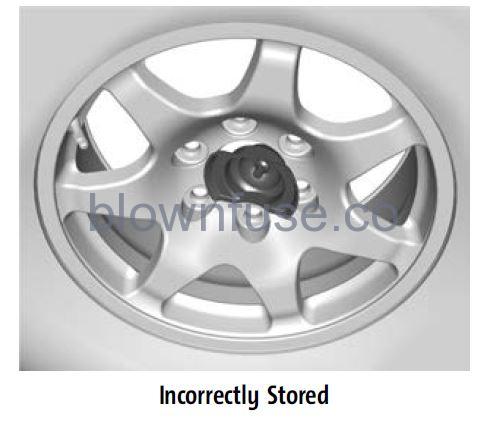
- Close the Hoist Shaft Access Hole Cover.
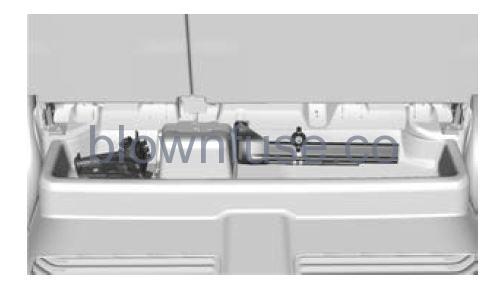
Return the jack and tools to their original location in the vehicle. See “Removing the Spare Tire and Tools.”
Full-Size Spare Tire
- If this vehicle came with a full-size spare tire, it was fully inflated when new, however, it can lose air over time. Check the inflation pressure regularly. See Tire Pressure 0 381 and
- Vehicle Load Limits 0 210 for information regarding proper tire inflation and loading the vehicle. For instructions on how to remove, install, or store a spare tire, see TireChanging 0 394.
- After installing the spare tire on the vehicle, stop as soon as possible and check that the spare is correctly inflated. The spare tire is made to perform well at speeds up to 112 km/h (70 MPH) at the recommended inflation pressure, so you can finish your trip.
- Have the damaged or flat road tire repaired or replaced and installed back onto the vehicle as soon as possible so the spare tire will be available in case it is needed again.
- Do not mix tires and wheels of different sizes, because they will not fit. Keep the spare tire and its wheel together.
Caution
If the vehicle has a four-wheel drive and a different size spare tire is installed, do not drive in a four-wheel-drive until the flat tire is repaired and/or replaced. The vehicle could be damaged and the repairs would not be covered by the warranty. Never use four-wheel drive when a different size spare tire is installed on the vehicle.
- The vehicle may have a different size spare tire than the road tires originally installed on the vehicle. This spare tire was developed for use on this vehicle, so it is all right to drive on it. If the vehicle has a four-wheel drive and a different size spare tire is installed, drive only in a two-wheel drive.
- If the vehicle has a spare tire that does not match the original road tires and wheels in size and type, do not include the spare in the tire rotation.
- If equipped with a temporary use full-size spare tire, it is indicated on the tire sidewall. See Tire Sidewall Labeling 376. This spare tire should not be driven over 112 km/h (70 mph), or 88 km/h (55 mph) when pulling a trailer, at the proper inflation pressure. Repair and replace the road tire as soon as it is convenient, and stow the spare tire for future use.
